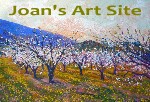The Eastern Aegean, Greece
Alan's Log:
Joan's Log:
Route from Naxos to
Chios
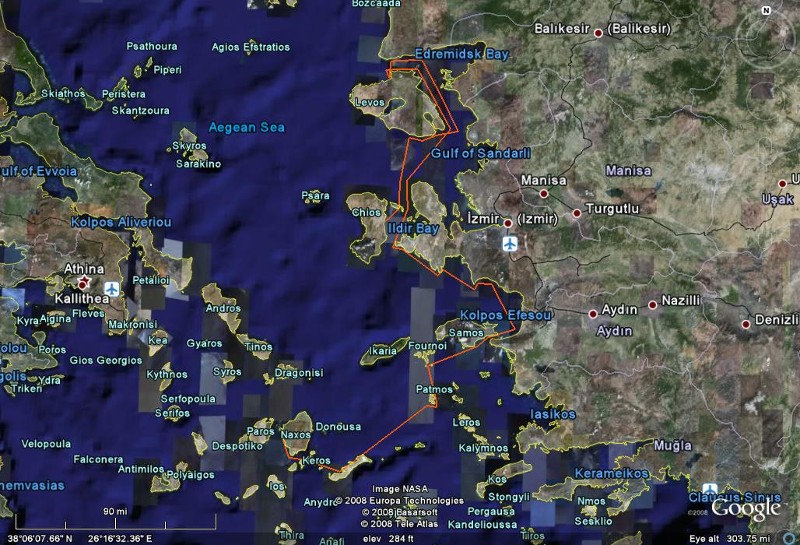
Not to be used for navigation.
The islands of the Cyclades were all starting to blend together like an impressionist painting. Barren rock islands with brilliant white cubist villages and twenty shades of blue. In the sky; the sea; windows and doors; interspersed with brilliant hits of magenta bouganvillea. I kept forgetting the names of the islands and the villages, they were all starting to look the same, the tavernas too. The same tables, chairs with rush seats, and the same menus over and over again. But most of all my nerves were becoming as frayed as our Greek flag by the continuous meltemis. I was ready for a change.
We bade a friendly farewell to Naxos, our base in the Cyclades; to Angela the friendly talkative Russian laundry manager who spoke only ten words in English; Stavros the harbor master who finished every conversation with a friendly pat on my back; and the crew at the breakfast cafe who pretended to look the other way while I occasionally poached their wifi connection without buying a coffee. It was time to head out, through the Dodecanese islands and towards the north-east Aegean where we will meet Lauren & Ben on Lesvos, then sail south with them to Chios.
Patmos, the most northern of the Dodecanese Islands
After a brief stop to swim and cool-off at the beach of Psili Ammos on the southwest side of Patmos, we continued around to the east side of the island and tied-up on the quay in the port town of Skala, it's a cruise ship destination and for good reason, this is where Saint John the Apostle wrote the big scary Book of Revelations also called The Apocalypse, after receiving a vision. He had been banished to the island for 2 years by the Roman Emperor, Domitian (I bet he was the domineering type). Once on Patmos, John found a cave to live in, now called the Sacred Grotto, which is where the vision occurred and where he wrote the book. Above the cave, at the very top of the hill is the enormous Monastery of St. John the Theologian, which looks more like a heavily fortified castle, the reason for which is it contains a treasure trove of religious icons and jewels. We went to the cave and even saw the rock that he used as a pillow, and the Monastery. I forgot I was supposed to dress appropriately in a skirt or dress, but no problem, they had a skirt I could borrow, one size fits all :0) . In the monastery, what amazed me were the books of gospels. Some dated back to 1000 to 1100 AD, beautifully hand-written on fine, thin leather pages, and still in incredible condition . I'm not the religious type, but I found the historical significance of the place astounding.After we finished visiting the monastery, we had a chilled Greek coffee at Jimmy's Balcony which offered stunning views of the town of Skala, the harbor, and tiny outer islands, we had heard it is THE place to be at sunset, maybe next time.
Marathi, a tiny island south west of Arki in the Dodecanese
One thing I found very attractive about this little gem of an island is that the dozen or so inhabitants subscribe to the Slow Food concept (near and dear to my heart) whether they are aware of it or not. They grow their own vegetables, raise their own livestock (goats), make their own cheese and yogurt (from the goats' milk), fish the surrounding waters, and cook it and serve it their tavernas. What's not to love? And they use solar power too. The only thing I saw coming in on a tiny ferry were fresh loaves of bread.This is truly a perfect "get away from it all" laid back utopia, where you can completely veg out for a few weeks. There are three beach tavernas, two with rooms to let, a pleasant beach and crystal clear water. We swam in from Moonstruck and had lunch in our damp swim suits, not a raised eyebrow in sight!
Samos, north-east Aegean
We spent one night at anchor just outside the harbor of Pythagorio and several nights on the quayside in the inner harbor.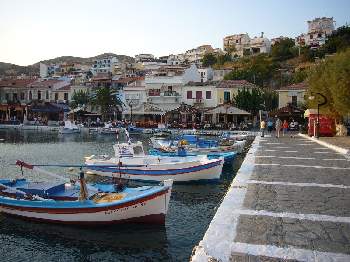
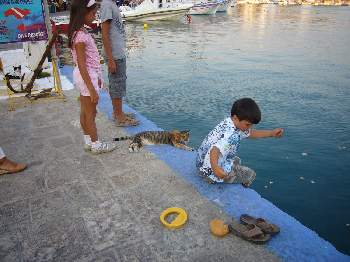
From Pythagorio, Turkey is only a few miles away and we could clearly see a huge Turkish flag on the far shore. We really enjoyed Pythagorio, although a bit on the touristy side, but what Greek island isn't this time of year? It seemed to be especially popular with Germans, who were in the vast majority. The town itself is very attractive, the architecture reflecting more of an Ottoman, Turkish influence with charming second-story overhanging enclosed balconies, usually painted a pretty pastel color. We loved walking along the quayside at night where all the colorful fishing boats were tied up, and everyone was out (including all the village cats) for the volte - a late evening stroll.
The first night we were there we lucked into seeing the Summer Cultural Festival put on by the islanders. Through dance and song, they re-enacted the rich history of the island.
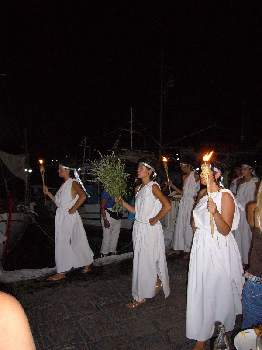
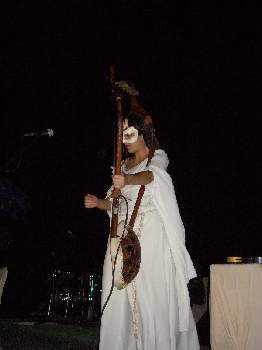
It was really well done, with a dramatic opening where hundreds of young island girls walked through the streets of the village and up to the stage, dressed in white togas and carrying flaming torches, to the rhythm of a slowly beating drum. A concert followed.
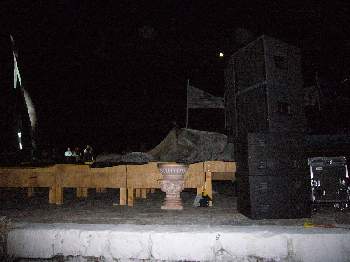
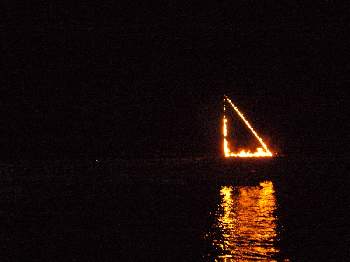
The music was played on reproductions of ancient Greco-Roman instruments and the finale was accompanied by setting a large triangle on fire on the harbour wall as a dedication to hometown hero Pythagoras.
Samos is the legendary birthplace of Hera, the wife of Zeus. It was also home to the great mathematician and inventor of atomic theory, Pythagoras, born in 580 BC, and is also the birthplace of the 4th century philosopher, Epicurus (I wonder if he was a good cook?).
Only a few miles from Pythagorio are the scattered remains of Ireon, the vast sanctuary of Hera and a World Heritage site. The road leading to it, called the Sacred Way, was once flanked by thousands of marble statues. Alan thinks we saw most of them in the Vatican museum in Rome! The sanctuary was once four times larger than the acropolis in Athens, but sadly, after centuries of earthquakes and plundering, only one column is left standing.
We decided it was high time we did a little hiking, Samos is well known by hikers and is loaded with trails. We read about a six mile round-trip trail that connects two remote mountain villages, Vourliotes and Manolates, and runs through the Valley of the Nightingales. Piece of cake! We rented a car and drove up to Vourliotes, a wonderfully quaint traditional village and just started following the signs to Manolates.
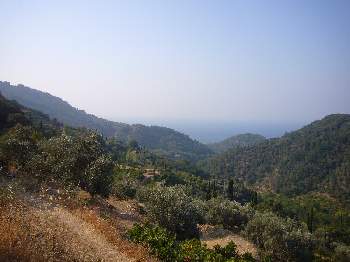
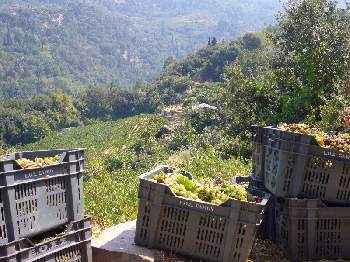
The trail began as a narrow, cobble-stone paved road at the edge of the village, which gave way to a rough rocky trail, which became a narrow dirt path which led us into a densely wooded pine forest, starting with a steep incline, which then dropping to a very steep descent down to the valley floor, where a heavily shaded stream trickled cheerfully. The signs we had been following gave way to faded red marks painted on fallen tree trunks, then to small cairns of rocks (which creeped me out a little. Remember The Blair Witch Project?) making the trail hard to follow.
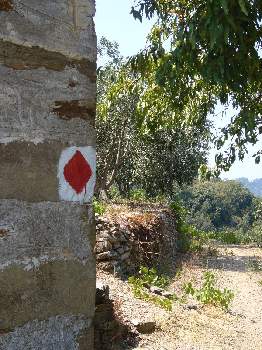
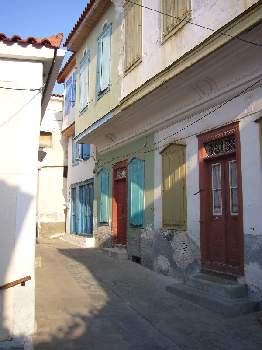
We took several wrong turns, once ending up in the middle of a terraced hill-side vineyard, the vines loaded with ripe grapes. This would have been a fantastic hike in early May, but this was mid-August and seriously hot and humid, which would probably explain why we never passed another person on the entire hike. From the valley floor the trail made a steep ascent up to the mountaintop village of Manolates. By now we were both pouring with perspiration. After an hour and three quarters we arrived into the adorable, fairytale village of Manolates, where people (who wisely drove there) were comfortably lunching in darling grape-vine shaded tavernas. They looked up with alarmed expressions at the two of us with our beet-red faces, panting and drenched to the skin, staggering past their tables. We were famished and thirsty, our water long gone. After downing a liter and a half of water we found a taverna, next to an ancient fountain, which was once used as the village communal laundry, where we shared a wonderful leisurely lunch of stuffed zucchini blossoms, olives and local feta, revithiokeftedes (a Samos specialty of fried chickpea patties with onion, tomatoes, and parsley), village sausage, and two ice cold beers; to regain our strength for the trek back. Four liters of water later we were back in Vourliotes, just as the sun was starting to set. It was a beautiful hike and I highly recommend it, just try not to do it in August.
Kusadasi, Turkey
Despite our proximity to Turkey, we have seen very few Turkish boats in the Greek Islands and we understand that there are even fewer Greek boats in Turkish waters. These two nations are historical enemies. They are still fighting a low-key cold war and have very little contact with each other.Since arriving in the Aegean we have been buzzed by low-flying F-16 fighter jets heading east about once a week. Usually there are three jets flying in a loose formation. They fly about 100' above the water, just 30' above our mast. They seem to change course to fly directly over us and they fly so low that they show up on our marine surface radar! We have learned that there is an active territorial dispute over sea and air space between Greece and Turkey. According to the Greek press the Turks are the aggressors and they throw up a few fighters every week to test and penetrate the territorial waters claimed by Greece, and the jets that we see are Greek fighters scrambled from Athens to engage in deterrent "mock dog-fights" with the Turkish planes. The jets fly so low that we can clearly see missiles under the wings and we wonder how "mock" these dog-fights really are. Apparently the last death was a couple of years ago when two opposing planes collided killing the crew of the Greek jet.
The cruisers we met in the Cyclades were generally heading west, having already cruised Turkey and the eastern Mediterranean. They all had good things to say about Turkey. "You'll love it. The people are so friendly; not loud and argumentative like the Greeks, they talk softly, laugh, they invite you into their homes, pour you tea at any excuse and are just the nicest people" On the other hand we were warned "take down your Greek courtesy flag before entering Turkish waters!" I was thinking that these are the same Turks that massacred 25,000 Greeks in 1822 on Chios and enslaved the remaining 45,000 and later razed the Greek town of Smyrna in the 1920's, killing many of its inhabitants.
Turkey will be interesting I thought as we slogged our way North-East against yet another meltemi.
We ducked out of the waves into a small bay where we found a safe anchorage as the 30+ knot wind whistled through the rigging for a day. Leaving our protected anchorage in 25 knots of wind the next morning was a gesture of faith, but the wind soon moderated to a pleasant 15 knots outside the bay and we sailed on a close reach for the Turkish entry port of Kusadasi.
Wow!!! We are in Turkey! About as far east as we plan to travel aboard Moonstruck. What a feeling, to have come so far. For Alan and I, a major accomplishment! For me there is also some trepidation, there is a travel advisory for those coming to Turkey...it is kind of a "hot-spot" right now. It borders from left to right Greece, Bulgaria, Georgia, Armenia, Iran, Iraq and Syria. Yikes! There have been bombings in Istanbul just this summer. We will be focusing our travels on the southern Aegean and Mediterranean coast, as far as we can get from the wars in Georgia and Iraq and other troublesome places.
The wind died as we neared the mainland coast of Turkey and hailed the marina on the VHF. For the past year since leaving Antigua, every harbour or marina entrance has been a solo performance for Moonstruck. We have had to figure out where to tie-up, how to deal with the prevailing wind, how the laid lines (if any) work, and where to drop our anchor so as not to cross anyone elses. All while dealing with boisterous winds and occasionally people yelling at us in foreign languages. So it was quite a shock when our VHF hail was answered in pleasant conversational English and we were directed to "Please enter the marina where the seamen will direct you to your berth and assist you!" Half an hour later we were tied up in Setur Kusadasi Marina. The marina staff had come out in a dinghy and led us to our berth, then secured the bow line for us! They even helped us hook up our electricity, there was plentiful good-tasting water and life was good again!*
*While proof-reading this paragraph anchored in a bay on the Turkish coast, two fighter-jets flew overhead heading East. This far East they are presumably Turkish jets heading home.
Turkey has got it going on when it comes to marinas! Setur Marina had everything...enough amps to run our air conditioners on the boat (100+ degrees outside) , luxury! Fast internet on the boat, luxury! A laundry (self-serve or full-service, we treated ourselves to the full service, wash, dry, iron and fold €25.00 or $35.00 US) LUXURY! A big swimming pool (we had not been in a pool since we left Florida, 2 years ago) luxury! and a large supermarket at the entrance to the marina, luxury! So, we decided to stay for a few days and regroup.
But first things, first, though...we needed to check into Turkey - it took us two days...don't ask, it just did.
The marina staff offered to handle our customs and immigration paperwork for us, for a fee of €40. But how hard could it be? I thought, so we gathered up our paperwork and set off at a brisk walk to the main port a mile away to handle it ourselves. The temperature was 100DegF and the marina staff had explained that we would have to visit 5* different offices to complete the paperwork for us and for the vessel. The first task was to get visas for our passports. It took visits to three different offices to find out that this was the first task, and it wasn't till the next morning that we were able to track down the visa officer. The second day we completed the remaining visits... (although we (Alan ;0) helped delay things further by leaving our passports on the boat). ...and at each stop we filled out a form, paid a small fee and collected the requisite stamp on our vessel transit log. Then it was back to the customs office where we had started, for a final stamp of approval. He looked over the visa and all 4 stamps - the one he had applied yesterday and three others. "There is one missing! Now you go to health department office near harbour authority office." I replied that we had already done everything exactly as he asked. We had returned to him as instructed straight after getting the harbour authority stamp. I remained seated. We both stared at the large space in the log for the missing stamp. The wall clock ticked loudly. It had been just over 24 hours since I first entered his office. After a few moments he opened a metal drawer, pulled out his official stamp and vigorously imprinted all seven copies of the log with a final seal of approval. We are legally in Turkey!
(*In order: Visa, Passport Police, Customs, Harbor Authority, Health Department, Customs sign-off)
Kusadasi, being a large city, near a major historical site, also meant it is a cruise ship destination, there were usually two or three in the port. That combined with tourists from all over Europe and being in the highest of the high season (August) meant big crowds. We walked through the bazaars, which are famous for Turkish rugs, leather goods and high quality knock-offs of every conceivable branded product. They were fascinating; loud, colorful, packed with merchandise. There was so much to see, everything seemed to catch my eye, causing me to linger and explore...there was just one thing standing between me and my shopping enjoyment...the highly aggressive sales people! There was just no way to look at anything without someone hassling me. I don't respond well to high-pressure sales tactics, I can only say "no...no, thank you...I'm just looking" about a hundred times without getting cranky. It took all the fun out of it for me and I just wanted to leave. I guess in the future I'll need to learn some coping skills if I want to pursue one of my favorite pastimes in Turkey!
Ephesus
The main reason to come to Kusadasi was to visit the ancient Greek/Roman ruins at Ephesus about 15 km away. We planned an early morning visit, to accomplish as much as possible before the 100 degree heat of the day kicked-in.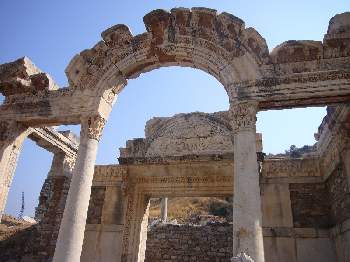
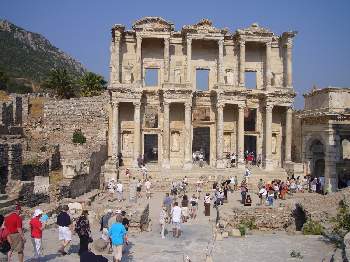
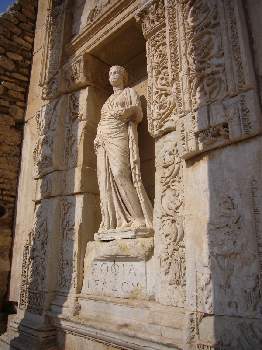
Ephesus is one of those crucible places in history. It crops up again and again as a place where important things happened. It was founded over 3,500 years ago. By 100AD it had half a million inhabitants and was the capital of Roman Asia.
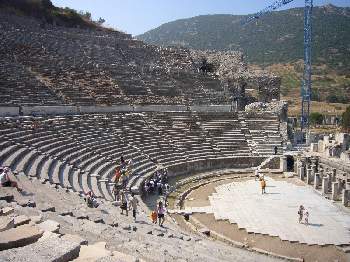
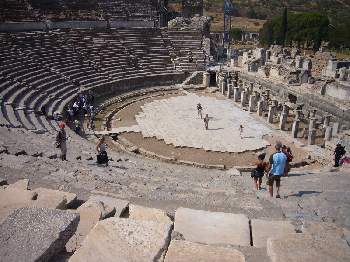
It was THE center for the worship of Diana/Artemis the goddess of the hunt and the temple of Artemis in Ephesus was one of the seven wonders of the ancient world. Sadly it was destroyed by the Goths in 300AD but there is still a tremendous amount to see here, including the great theatre which seats 25,000 and the mile-long marble colonnade where Anthony & Cleopatra entered the city by chariot.
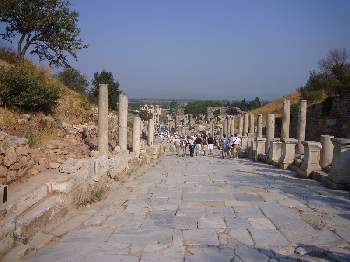
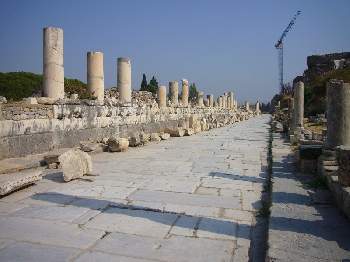
The Roman baths here contain the first known instance of indoor plumbed toilets, flushed by running piped water beneath the latrines.
The Apostle Paul (Saint Paul) spent his longest missionary tour here (Acts 18-20) and preached at the great theatre, causing a riot of the silversmiths who could see the writing on the wall for their business if christianity displaced Artemis. As a result of the riot Paul was asked to leave.
Not long after, the Apostle John (or John the Evangelist or John the prophet who wrote the Revelation, depending on your sources) arrived with the Virgin Mary, whom he had promised to Christ on the cross that he would look after. He installed her in a house on the outskirts of town, where she spent the rest of her life.
In 431AD the Third Ecumenical Council proclaimed Mary "Mother of God" at a meeting in Ephesus.
The city had large elaborate fountains, theatres, an atheletic stadium with baths and multi-storey apartments for the middle-classes. Eventually however the good times faded. The river silted up the harbour and Ephesus gradually declined. Eventually it disappeared entirely from view and was only rediscovered in the 1800's. Today the coast is three miles away and excavations have been continuing for the last 120 years to uncover its secrets.
We however, uncovered the secrets of Ephesus along with 2,000 others on a single sweltering August day.
Sigacik and Eskofoca, Turkey
We meandered up the Turkish coast stopping at the small impoverished town of Sigacik for a night.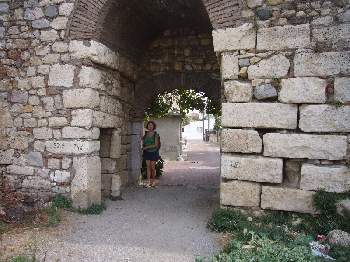
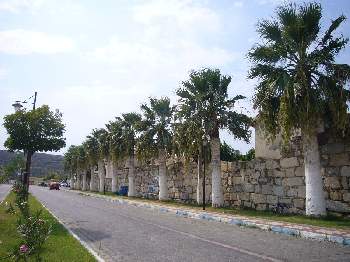
An unfinished marina provided a place to tie up, and we were charged for the privilege, despite there being no electricity or water and being marooned on a pier not connected to land!
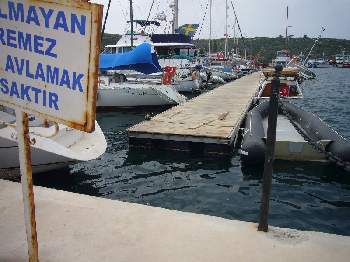
Next was Eskofoca which was a pleasant enough spot for a day, however we were trapped by yet another meltemi and spent several days at anchor here. Truth be told we were finding this part of the Turkish coast not very interesting. The architecture is completely bland, the attractive coastline is cut up with ill-conceived developments and ugly apartment-style buildings and we have yet to meet a friendly turk
We decided to return to Greece, doing so required that we check out of Turkey so we sailed north to Ayvalik. Unfortunately the marina in Ayvalik was completely full, so we anchored overnight in nearby Alibey. I was keen to watch the F1 car race scheduled for the afternoon and after wandering the streets in a vain search for a sports bar I finally heard the unmistakable sound of racing engines coming from the back room of a restaurant. I wandered in to find an employee taking a break and watching the race on a small TV. I expressed interest in the race and he beckoned me to sit down, shortly bringing me a tea, then a beer. Joan joined me and the owner came in and started ordering everyone around. We sat tight not quite knowing whether to stay or leave, but enjoying the race nonetheless. After a few minutes a large table had been set up in the room and piled high with dishes. The owner beckoned us over and insisted that we sit and join him for lunch. We had already had lunch, but weren't able to communicate that to him. Neither of us spoke a word of each other's language. He placed a large squid on each of our plates and beckoned us to start eating. He waited to see us start before starting his own meal. It was impossible to refuse without being rude so we tucked in, but as each of us finished our large whole squid, including ink, another was immediately put in its place!. We somehow managed to eat several of these before realizing that the only way to stop our plate being reloaded was to not try to finish the previous one. At about the time this dawned on us more dishes arrived. There were piles of deep fried whitebait (small fish fried whole), A spinach-like vegetable that we have not seen before, huge planks of bread, a dish of stewed eggplant and tomato, a green salad. It all looked very good but we were not hungry. Our gracious host however helped us to a large serving of each of these dishes. We simply could not refuse him. Somehow we struggled through. The food over, we returned to the TV to watch the end of the race to see Hamilton win brilliantly in the rain (later relegated to third for an infringement). We tried to pay for lunch and for the drinks, but the owner was having none of it. We were his guests in his home. It was a unique experience.
Mytilini, Lesvos, Greece
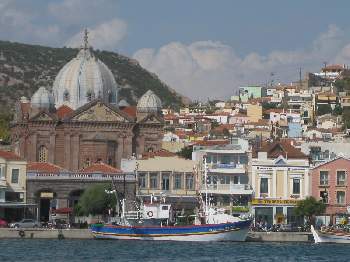
Back in Greece on the island of Lesvos. We stern-tied to the harbor wall in the frenetic, pulsating heart of Mytilini,
Goat it may have been, the nuggets were where the meat of a lamb chop would have been but they were only the size of a quarter. Anyway marinated with oil, pesto, pepper and garlic I thought they were pretty good. Luckily Joan didn't like them, there were definately not enough for two!
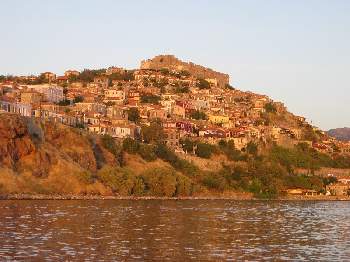
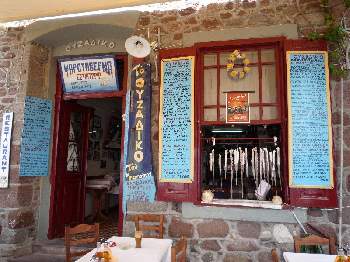
There are two very pretty harbours at the north of Lesvos and Molyvos
We have been to some pretty villages in Greece, but Molyvos was really special. We had side-tied Moonstruck on the quay on the far side of the harbor, giving us the perfect view of the town, built around a steep hill which is typical of many Greek villages. Molyvos stands out like a multi-layered cake, decorated with silvery colored stone houses with burgundy, blue and green trim, twisting steep cobblestone streets, shaded by ancient wysteria vines with trunks as thick as oak trees, all topped off with a golden 14th century Venetian castle. At night it is all lit up and positively glows.
It is the second week of September and suddenly we have Greece all to ourselves, it has started to feel a little lonesome in the tavernas, the beaches are practically empty, and the kids have all gone back to school. Everyone has packed up and gone home, with the exception of a few older Scandinavian stragglers. The sense of change is heavy in the air.
We have chosen this pretty village as the jumping off point of Lauren and Ben's visit with us on Moonstruck. From here we will take them down the eastern side of Lesvos, take a ferry trip to Turkey from Mytilini, stop in Plomeri and then head on to the island of Chios, from where they will fly home.
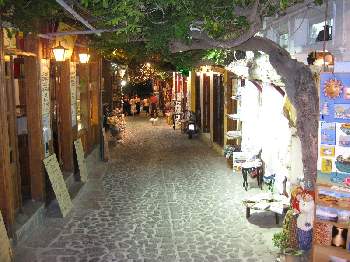
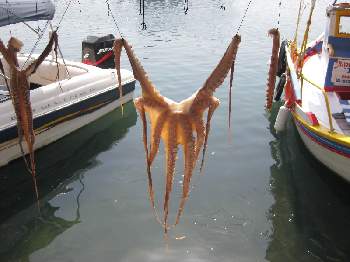
It seems that all the most attractive towns we visit were settled, or taken, by the Genoese. They built countless castles, defensive towers, lookout towers and entire villages throughout the Mediterranean and we have seen their work from Corsica all the way to north-east Greece. Molyvos is a perfect example. It has a small well-protected harbour, a tiny village around the harbour and a larger one up the hill that leads to the large Genoese castle. The streets are cobbled, impossibly steep and many are stepped. The houses were built almost literally on top of each other. Most of the larger houses were built during the later Turkish occupation and feature typical Ottoman features. They are stone houses with attractive overhanging wooden balconies and clay tile roofs. Of the castle, only the exterior defensive walls remain. The interior stonework has largely been raided over the centuries to build the village. It commands a 360 degree view over the low-lying surrounding countryside and over the sea north to Turkey.
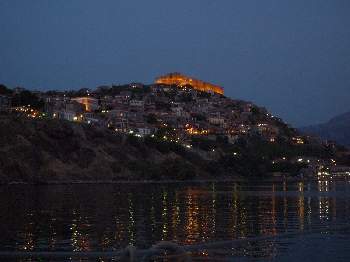
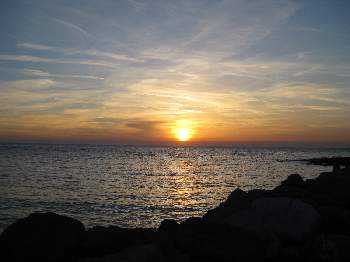
Lesvos is of course known as a playground for Sapho and her modern day followers.
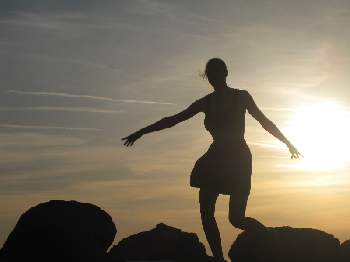
Molyvos in particular was full of gay female tourists enjoying the scenery during our visit. Unfortunately the appropriation of the moniker 'Lesbian' by the gay women of the world has accidentally deprived the inhabitants of Lesvos of their identity - they come from Lesvos, but they can no longer say that they are Lesbians without attracting the wrong kind of attention, especially the men! Some locals use the Lesbian moniker, and local products are similarly tagged which leads to some intriguing menu items.
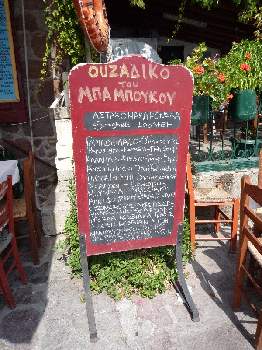
A Grecian Day Spa and Dolphins!
After leaving Molyvos we stopped off for a thermal hot-spring experience, for four euros each we could use the therapeutic hot spring for an hour. The hot spring was a rather rustic shallow pool with a pebble bottom, inside an unlit small domed building like a miniature Greek church, with small round holes in the roof letting in bright shafts of sunlight, shining like spot lights into the pool. It is right on the beach. New Age music played softly and tiny votive candles flickered in niches in the walls. The idea was to soak in the hot (really hot!) pool for as long as you could and then soak in the cool sea, just outside the door, then repeat until the time was up. What a great deal and it worked too! Lauren had a stiff neck and I had a backache, both vanished. Alan and Ben just simmered and lolled and liquified into a state of pure nirvana. When we left I felt like an over-cooked noodle in chicken soup!Back on the boat as we headed down the coast to Mytilini, Lauren and Ben were treated to a fantastic dolphin visit, when seven or eight dophins swam in our bow wake and happily posed for photos too.
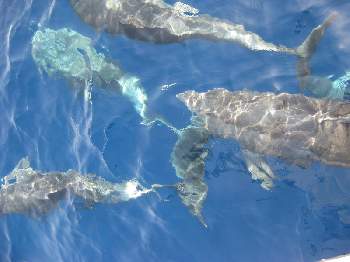
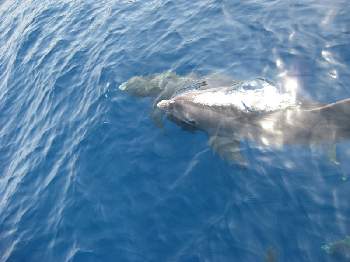
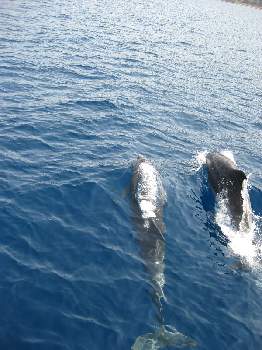
Pergamum
Back in Mytilini we booked a ferry trip and tour of the famous Pergamum site near Dikili Turkey, to give Ben & Lauren a taste of the Orient. Being so late in the season, the only tour we could schedule was guided only in Greek. We bought our tickets and took the morning ferry to Dikili, followed by a narrated bus journey to the Pergamum site. We could not understand the narration of course but when the bus stopped we could see the ancient amphitheatre at the top of a nearby hill. We explored the area around the bus - the site of the sanctuary of Asklepios - an ancient place of healing, then got back on the bus with the rest of our small group for the ride up to the amphitheatre. I was enjoying the air-conditioned ride, thankful that we would not have to hike up to the amphitheatre, and no one was more surprised than me, when the bus headed 15 miles in the other direction, eventually stopping at a large tourist restaurant for lunch! Apparently we would not see the amphitheatre up close - and not understanding or speaking Greek made it impossible to find out why!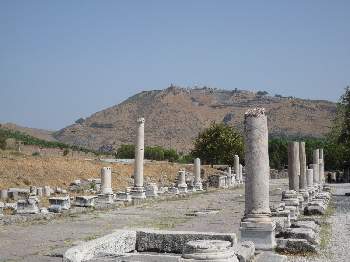
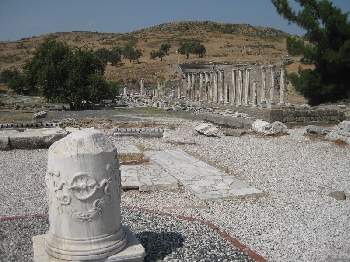
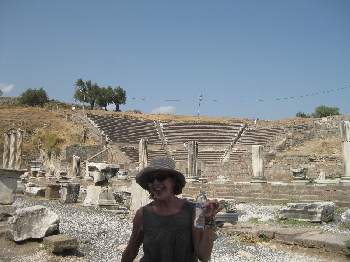
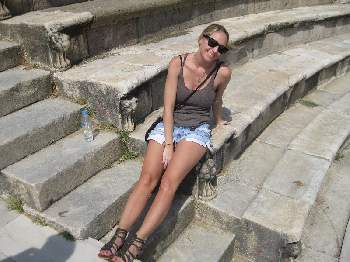
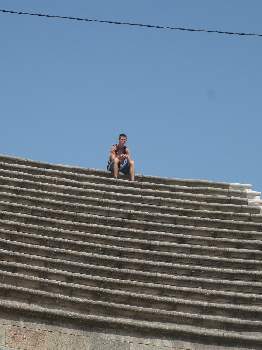
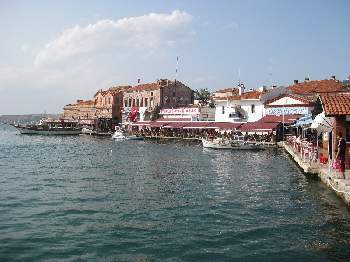
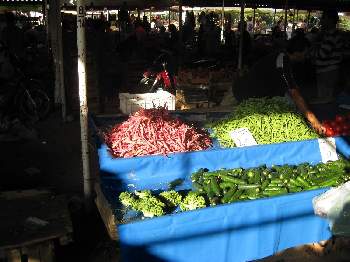
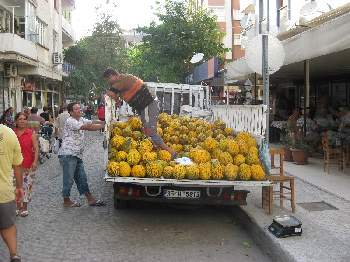
Tarti Beach, Lesvos
We spent an afternoon on the beach at Tarti, one of the best beaches on the island, very quiet at this time of year, but it gave Lauren and Ben an opportunity to soak up some rays and swim. I, at this point, have had all the sun, my freckled body can handle and chose the shade of a taverna just behind the beach.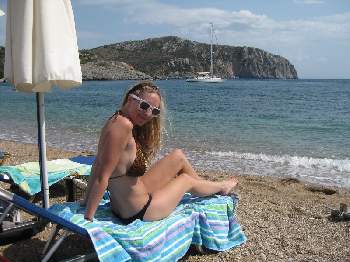
Alan and I had a beer and ordered lunch, since Lauren and Ben are not adventurous eaters, we ordered them a nice safe pork souvlaki (kebab), while we shared a Greek salad, an order of zucchini blossom patties and an order of fresh fava beans dressed in beautiful local olive oil. I might add that Lesvos is famous for it's olive oil, practically the entire island is covered with olive trees and some of the highest quality olive oil in the world comes from this island. The simple combination of the oil and fresh beans was genius! When the food arrived Lauren and Ben joined us, eyeing the zucchini blossom patties, Lauren asked "what are those?" Alan's quick reply was "oh, those are hush puppies, try one". "Wow, these are good!" was Lauren's reply, even Ben agreed! If you're reading this, Lauren or Ben. Gotcha!!!!! :0)
Skala Loutron - Hotel Zaira
En route to Plomeri we anchored for a while in Skala Loutron, a protected bay on the south coast of Lesvos adjacent to an old olive pressing factory that has been turned into the boutique Hotel Zaira. It is a lovely place, redolent with history and beautifully restored. We planned to just walk through and then have lunch in a small taverna nearby, but the season is ending and the tavernas in Skala Loutron have already closed. Music coming from Zaira lured us inside where we heard a succession of lovely violin solos. In the old factory itself, next to an old press, a series of young russian solo violinists were training with their maestro. After a while they broke for lunch in an open courtyard which we shared with them. Each had a purple bruise just under the side of her chin, the tell-tale sign of a serious violinist.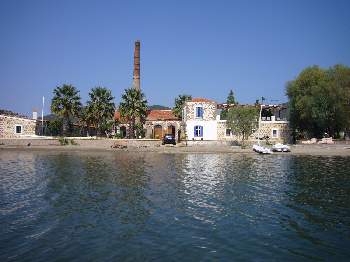
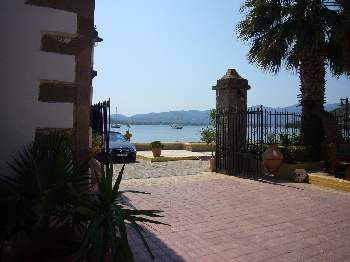
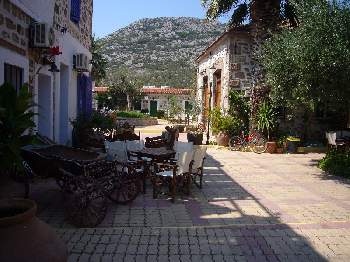
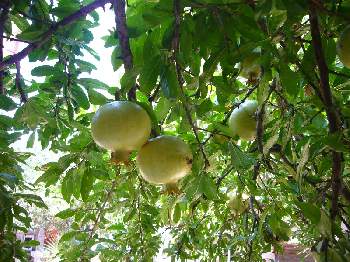
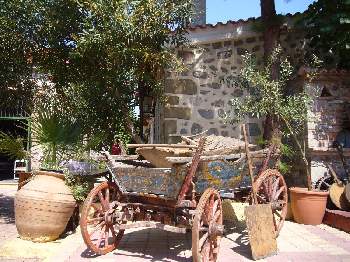
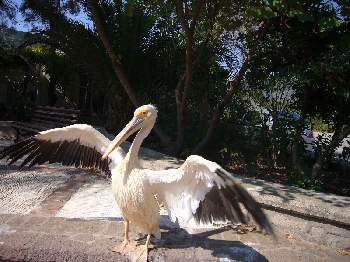
Plomeri Lesvos
Plomeri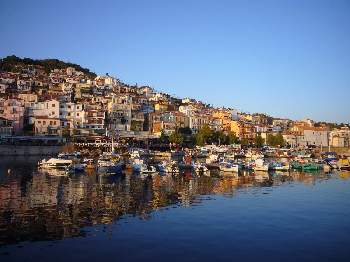
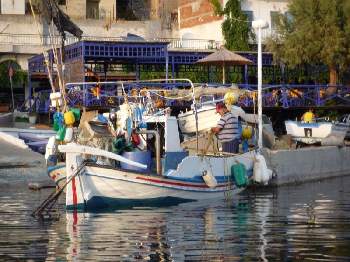
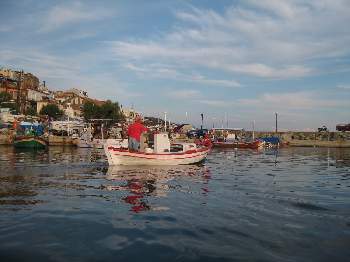
The village grew up around a seasonal creek, which is now concreted and runs below street level. During the summer it functions as an impromptu road and it is not unusual to stand on a bridge expecting to see water below only to have several mopeds race by beneath you. The central Platari square is very attractive. Shade here is provided not by beer-branded umbrellas as elsewhere, but by a centuries old plane tree.
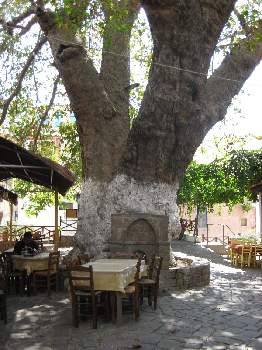
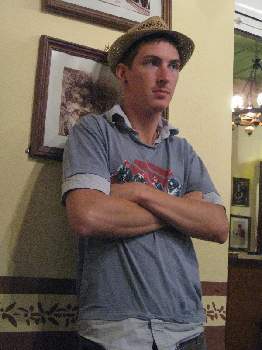
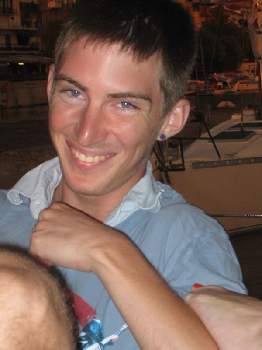
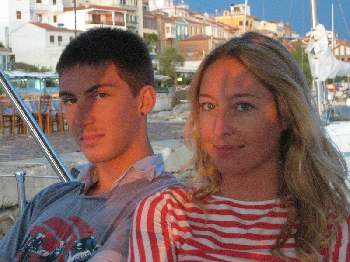
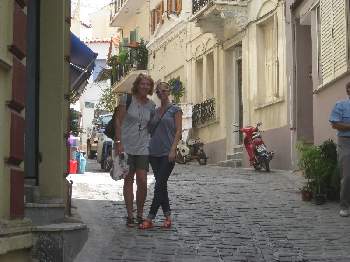
The trunk is probably 12' wide and its branches shade half a dozen tavernas. In the evenings a small group of musicians plays here. We were lucky to catch their last performance of the summer.
When we sailed into the harbour we tied up between two fishing boats. We followed a day-tripper boat into the harbour and one of the crew - turned out he was the owner - was kind enough to help us with our lines.
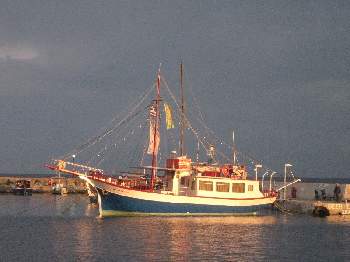
A couple of days later I was out on my bicycle looking for a refill for my propane/butane tanks. Having failed to correctly follow the directions I was given, I stopped at a rental car office for help. Lo and behold the owner was the same guy that helped us with our lines. He had seen me wandering around forlornly and offered me a ride to the filling station. I hopped on the back of his Honda 50 and off we went. Helmets are unknown here. My mother is worried about our Atlantic crossing home next year. She should be more worried about massive head wounds from moped riding! We did not score butane, but he did get us a great deal on a new bright yellow rental car and the following day we went exploring the south of the island. After a couple of miles the tarmac ended and we were on a rough stone track that lasted for 15 miles as we wound our way up and around Mount Olympos. The odd thing was that this rough track and its intersections were signposted as if it was a real road. I forgot to take my cell phone, and the sharp flint gravel had me worried about getting a puncture but every now and again, when we thought we were the only people out in the middle of nowhere we would come across another underpowered rental car ploughing through the dirt in the opposite direction. Our destination was Agiassos a too-cute-to-be-true hill village. It has a 12th century church with the most unusual interior I have seen in a while, all the interior walls and interior columns are black. Around the church and built into its very foundations are shops and an old bazaar. The streets are cobbled, the houses tiled, and the streets are sheltered from the sun by massive ancient vines. All in all it is a well presented tourist village with tons of quaint boutiques and shops selling mainly locally carved wood.
We usually enjoy trying new dishes, but we were not sufficiently adventurous to try the local specialty, which is a soft cheese, matured by being sewn inside a the skin of a sheep! It is displayed, unrefrigerated, and nestled in its sliced-open alien skin - not an attractive sight to our eyes.
Back in Plomeri, I got up early one morning, awakened by the fisherman next door docking his boat after his regular night's work. When I came on deck he and his wife were cleaning and cutting up a large Mahi-mahi. I asked if I could buy some steaks. They spoke NO English. In fact 'no' was the only English word that the wife apparently knew, She said no (not 'nea' which means 'yes' in Greek), she shook her head no and pointed towards the fishmarket in the village. I understood that all their product was to be sold there, so I went back below. Half an hour later I was back on deck as they were getting ready to leave on their small moped. The fisherman gruffly dropped four lovely Mahi-mahi steaks into my hands and waved off my offer of money to pay for them.
I was taken aback by his kindness. We are constantly surprised as we wind our way through these islands, by considerations large and small that we do not expect. This was one of the larger ones. These steaks would have set me back nearly €40 ($60) in the fishmarket.
Bumper Crop
While we were in Plumeri I became friendly with Stavros, a ragged yellow tabby cat, he had staked out our end of the quay as his land and ruled it with an iron paw! He fiercely sent all other kitties packing in the opposite direction. One night we fed him the remains of our wonderful grilled mahi-mahi dinner, which he devoured in about two minutes.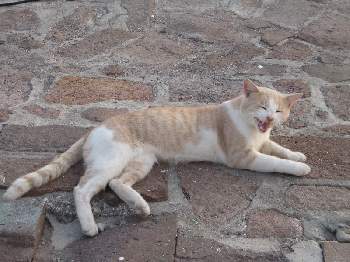
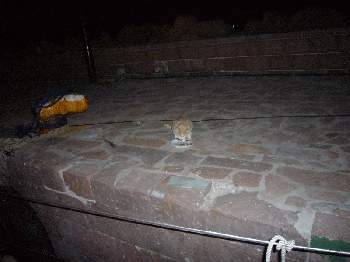
After that I made a deal with Stavros, I would feed him, if he wouldn't pee on our boat. He didn't keep his end of the bargain, but I forgave him. He has a long winter ahead of him, and besides he was only marking Moonstruck as his territory. Sadly for him it wasn't a permanent arrangement.
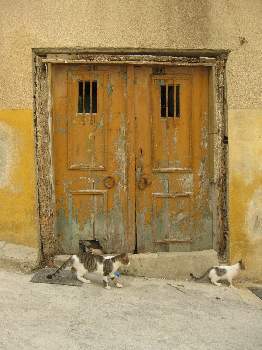
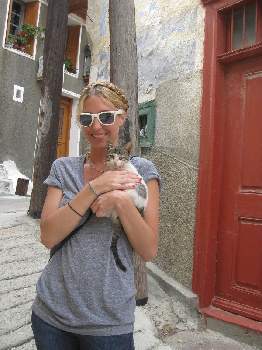
Over the past few months I have been increasingly concerned about the plight of the hundreds of thousands (possibly millions) of stray cats and dogs in Greece. It seems nothing is being done by the government to control the situation. On a few islands I have noticed grass-root organizations (usually run by British ex-pats) collecting change for homeless animals. During the summer the cats get fed by the tourists in the tavernas, but during the winter when the tourist are gone, only the strong survive. Nowhere in the Greek islands have I noticed more stray cats than on Lesvos, they are literally everywhere! And there seems to be a population explosion going on now in September, at the worst possible time of year, a bumper crop of kittens.
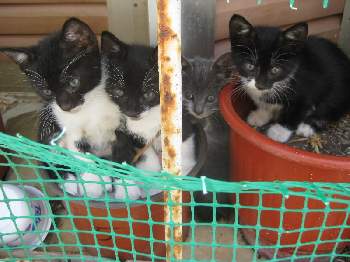
I have seen so many sad sights, from Stavros, to a tiny pregnant adolescent, still just a kitten really, curled up in a chair in the car rental office. Chris, the lady who ran the office told me she just showed up one day and decided she was home! She wished she could take her home, but she already had three cats of her own, and they will be closing the office soon for the season. Last night I saw a lone tiny kitten, no older then six weeks, running down the middle of a busy pedestian street, crying at the top of its lungs. Somehow it had gotten separated from its mother. Lauren picked it up for a few minutes to try to calm it, and then reluctantly let it go. I feel so bad for them, I now have a big bag of cat food on board, and I feed as many as I can!
Next we are off to Chios....and the adventure continues here

